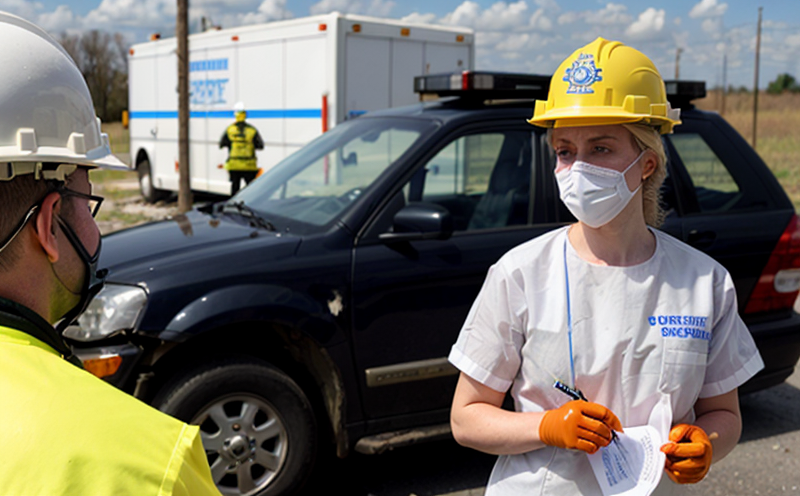ASTM E181 Film Badge Dosimetry in Emergency Conditions
The ASTM E181 film badge dosimetry method is a critical tool for monitoring occupational and environmental radiation exposure, especially during emergency conditions. This technique involves the use of film badges containing a radiation sensitive material (typically a combination of silver bromide and other compounds) which can record the amount of radiation absorbed by an individual over time.
During emergencies such as nuclear accidents or industrial incidents involving radioactive materials, accurate and rapid dosimetry is essential for assessing the extent of exposure and ensuring appropriate medical interventions. ASTM E181 provides a standardized procedure to ensure that all film badges used adhere to strict quality control measures, thereby enhancing reliability.
The process begins with the distribution of film badges to personnel who may be exposed to radiation. These individuals then wear the badges during their duties until they are collected and processed for analysis. The film badge is developed using a specific chemical process that results in a visible image on the film, indicating the amount of radiation absorbed.
Once developed, the film badges undergo meticulous quality control checks to ensure accuracy and reliability. This includes comparing readings with known reference standards and checking for any anomalies or errors in the development process. The final step is the interpretation of the images, which involves quantifying the radiation dose based on the degree of darkening.
ASTM E181 ensures that all film badges used meet stringent quality control criteria, which are essential for accurate dosimetry during emergencies. This standardization not only enhances the reliability of the results but also minimizes the risk of errors that could lead to incorrect medical decisions or insufficient protective measures.
The method is particularly useful in scenarios where immediate and precise dose assessments are required. For example, following a nuclear accident, emergency responders need reliable data on their radiation exposure to ensure they receive appropriate care. Similarly, in industrial settings, workers exposed to radioactive materials during an accident can be quickly assessed for potential health risks.
ASTM E181 also facilitates the use of film badges in situations where other dosimetry methods are impractical or unavailable. In remote areas or during rapid response operations, film badges provide a portable and robust solution that does not require immediate access to sophisticated equipment.
The accuracy and reliability of ASTM E181 film badge dosimetry are paramount in emergency conditions. By adhering strictly to the standard, laboratories can ensure that the data collected is accurate and reliable, thereby supporting informed decision-making regarding medical interventions and protective measures.
Industry Applications
The ASTM E181 film badge dosimetry method finds extensive application in various industries where occupational exposure to radiation is a concern. These include nuclear power plants, hospitals, research facilities, and industries handling radioactive materials.
In nuclear power plants, the method is used to monitor workers involved in reactor maintenance or decommissioning processes. These activities often involve short-term but high-intensity exposures that require accurate dose assessments for both immediate safety measures and long-term health monitoring.
Hospitals, especially those with diagnostic imaging departments like CT scans or nuclear medicine units, also use film badges to monitor staff exposure during patient examinations. This helps in maintaining compliance with radiation protection standards while ensuring the safety of healthcare workers.
Research facilities, particularly those involved in high-energy physics experiments or radiopharmaceutical research, rely on ASTM E181 for comprehensive dosimetry monitoring. The method provides a cost-effective and reliable way to track exposure levels over extended periods, supporting both operational efficiency and occupational health.
In industries handling radioactive materials, such as mining or waste disposal operations, film badges are used to ensure that workers are not exposed to excessive radiation during routine tasks. This is crucial for maintaining compliance with safety regulations while minimizing potential risks to personnel.
Customer Impact and Satisfaction
The implementation of ASTM E181 film badge dosimetry in emergency conditions has a significant impact on the quality management practices of various industries. By providing accurate and reliable dose assessments, this method enhances occupational safety, thereby increasing customer satisfaction.
For nuclear power plants, the use of ASTM E181 ensures that workers are protected during high-risk operations. This not only reduces the likelihood of radiation-related health issues but also demonstrates a commitment to worker safety, which is crucial for maintaining public trust and regulatory compliance.
In hospitals, accurate dosimetry monitoring helps in reducing exposure risks among healthcare workers, thereby enhancing patient care quality. This contributes to improved outcomes and better service delivery, directly impacting customer satisfaction.
Research facilities benefit from the precise dose assessments provided by ASTM E181, which allows them to optimize radiation usage while ensuring compliance with international standards. This leads to more efficient operations and higher-quality research outputs, ultimately benefiting all stakeholders involved.
Industries handling radioactive materials appreciate the reliability of ASTM E181 in providing consistent dose data. This helps in making informed decisions regarding protective measures and operational protocols, thereby minimizing risks and enhancing overall safety standards.
Environmental and Sustainability Contributions
The use of ASTM E181 film badge dosimetry in emergency conditions plays a crucial role in environmental protection and sustainability efforts. By ensuring accurate monitoring of radiation exposure, this method helps prevent accidental releases that could harm the environment.
In nuclear power plants, accurate dose assessments are essential for maintaining safety during routine operations and emergencies. This helps in minimizing the risk of radioactive contamination, thereby protecting both the local ecosystem and public health.
Hospitals can use ASTM E181 to monitor and reduce unnecessary radiation exposure among staff and patients. By optimizing diagnostic procedures and protective measures, this contributes to a more sustainable approach to healthcare delivery.
Research facilities benefit from the precise dose assessments provided by ASTM E181 in managing their radioactive materials responsibly. This helps in reducing the environmental footprint of such operations while ensuring compliance with international standards.
In industries handling radioactive materials, accurate dosimetry monitoring is crucial for preventing accidental releases that could contaminate soil and water resources. By adhering to ASTM E181, these industries can contribute positively to environmental sustainability efforts.





